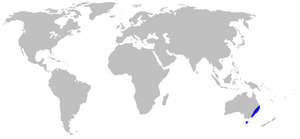Christmas bells facts for kids
Quick facts for kids Christmas bells |
|
|---|---|
 |
|
| Illustration of Blandfordia grandiflora by Edward Minchen | |
| Scientific classification |
|
| Kingdom: | Plantae |
| Clade: | Tracheophytes |
| Clade: | Angiosperms |
| Clade: | Monocots |
| Order: | Asparagales |
| Family: | Blandfordiaceae R.Dahlgren & Clifford |
| Genus: | Blandfordia Sm. |
 |
|
| Distribution | |
Christmas bells are beautiful flowering plants found in eastern Australia. They are also known by their scientific name, Blandfordia. There are four different types, or species, of Christmas bells. These plants grow in clumps and come back year after year (they are perennial herbs). They have long, thin leaves and can grow up to twenty large, bell-shaped flowers that hang downwards.
Contents
What Christmas Bells Look Like
Christmas bells are monocots, which means their seeds have one leaf when they sprout. They grow in clumps from a special underground stem called a corm, which is like a bulb. They have roots that can be thick and fleshy, or like fibers, or even like small tubers.
Their leaves are long and thin, growing close together in two rows from the bottom of the flower stem. Up to twenty flowers grow near the top of the stem. These stems have small, leaf-like parts called bracts.
The flowers are usually red with yellow tips. The outer parts of the flower, called sepals and petals, are joined together. They form a tube-shaped flower that looks like a bell or a cylinder. This tube has six small lobes, which are about one-fifth the length of the tube.
Inside the flower, there are six stamens (the parts that make pollen) attached to the inner wall of the flower tube. The style (part of the female reproductive organ) is long and thin. Christmas bells usually flower in spring or summer. After flowering, they produce a fruit called a capsule. This capsule is pointed at both ends and holds many small, hairy brown seeds.
Naming and Plant Family
The scientific name Blandfordia was first officially described in 1804 by a botanist named James Edward Smith. He used dried plant samples sent from Sydney by a surgeon named John White. Smith published his description in a book called Exotic Botany.
The name Blandfordia was chosen to honor George Spencer-Churchill, 5th Duke of Marlborough, who was also known as the Marquis of Blandford. The first type of Christmas bell described by Smith was Blandfordia nobilis, which is considered the type species for the whole group.
Blandfordia plants belong to their own special family called Blandfordiaceae. This family is part of a larger group called the order Asparagales, which includes many other monocot plants. The Blandfordiaceae family is unique because Blandfordia is the only genus in it. Scientists have only recently agreed to recognize this family. The APG IV system, which is a way of classifying plants, has recognized this family since 1998.
There are four main species of Christmas bells that are recognized by plant experts:
- Blandfordia cunninghamii Lindl. (found in New South Wales)
- Blandfordia grandiflora R.Br. (found in Queensland and New South Wales)
- Blandfordia nobilis Sm. (found in New South Wales)
- Blandfordia punicea (Labill.) Sweet (found in Tasmania)
Where Christmas Bells Grow
Two of the four types of Christmas bells are only found in New South Wales, Australia. A third type grows in both Queensland and New South Wales. The fourth type is only found in Tasmania.
Christmas bells usually grow in areas with low, open shrubs called heathlands. They especially like places where the ground is wet, often near the coast. Some groups of these plants can also be found on higher land called tablelands.
Growing Christmas Bells
Christmas bells have large, unique flowers that last a long time after being cut. This makes them popular for selling as cut flowers. A small number of growers sell them both in Australia and to other countries.
These plants are protected by law. In the past, too many flowers were picked from the wild. This caused some groups of Christmas bells to disappear from certain areas and also harmed their natural homes.

